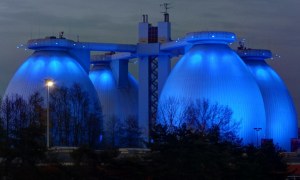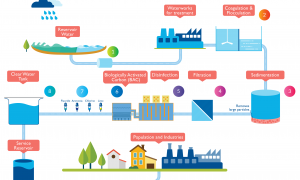🕑 Reading time: 1 minute
Design of each elements for the construction of sedimentation tank is necessary for effective treatment of wastewater for removal the suspended particles. Various components of sedimentation tank and their design basis is discussed.Contents:
Design Elements for Construction of Sedimentation Tank
The sedimentation tank is constructed based on many factors. Some important design elements of sedimentation tank are:- Detention period
- Displacement efficiency
- Surface loading
- Basin dimensions
- Inlet and outlet arrangements
- Sludge removal devices

Detention Period of Sedimentation Tank
Detention period is a time taken by a water particle to travel from inlet to outlet of settling tanks. It is the ratio of volume of basin to discharge rate.Detention period (t) = V/Q
Where V = volume of basin
Q = discharge rate
So, if the volume of basin is increases, detention period also increases. It also depends on the quantity of suspended particles in water. In general, detention period is in between 4 hours to 8 hours.Displacement Efficiency of Sedimentation Tank
Displacement efficiency is the ratio of flowing through period to detention period. Flowing through period is the time taken by a batch of water to travel from the entry to exit of settling tank. Because of short circuits produced in water current, flowing through period is less than the detention period. Flowing through period can be calculated easily. For this, sodium chloride is added to influent and after some time collected effluent is subjected to chloride content test which decides the flowing through time. In general, flowing through period should be at least 0.3 times the detention period and displacement efficiency should be 0.25 to 0.5.Surface Loading
Surface loading is nothing but over flow rate which is equal to the amount of water passing per day through one unit of horizontal area. Here, the amount of water passing per day is nothing but discharge rate.Hence, surface loading = Q/A = liters per day per square meter.
According to above equation surface loading is also equal to velocity of settlement which is defined as ration of discharge rate to area.Basin Dimensions of Sedimentation Tank
Basin dimensions of sedimentation tank are derived from its area. So, first step is to calculate the area of basin. The basin area is derived from the volume of water in liters per hour and surface loading rate. Hence,From the derived area, the three dimensions of tank (length, width, depth) are calculated based on the following conditions:Area of basin = volume of water / surface loading rate
= liters per hour / liters per hour per m2
= m2.
- The depth of basin should be 3 to 4.5 meters.
- The width should be greater than or equal to 0.25 times of its length.
- The width should not be more than 12 meters.
- The cross-sectional area provided should allow horizontal velocity of 0.3 meters per minute.
Inlet and Outlet Arrangements of Sedimentation Tank
There is an inlet and outlet for the basin. When the influent is coming from the inlet and effluent is discharged through outlet some disturbance is created. So, the inlet and outlet should be well designed to minimize this disturbance. Sometimes, due to turbid nature or of larger weight the influent sinks into the bottom of tank and rise at the outlet which causes back water flow and also reduces detention period. This can be overcome by two methods. One is by installing submerged weir with submerged inlet, that is, inlet at the bottom of tank. The other method is baffle wall provided at the inlet which have perforated opening at the bottom. Similarly, at the outlet, also we have two methods. First is to provide simple outlet weir which reduces the horizontal and vertical velocities of water at outlet. The second method suggests, provision of floating arm outlet, of which in end is hinged at bottom and bell mouth entry at its top.
Floating arm outlet is generally provided 20 cm below the normal water surface to avoid the floating impurities.
Similarly, at the outlet, also we have two methods. First is to provide simple outlet weir which reduces the horizontal and vertical velocities of water at outlet. The second method suggests, provision of floating arm outlet, of which in end is hinged at bottom and bell mouth entry at its top.
Floating arm outlet is generally provided 20 cm below the normal water surface to avoid the floating impurities.

Sludge Removal Devices for Sedimentation Tank
Sludge separated in sedimentation process should be collected from the tank either manually or mechanically. The manual removal is possible for smaller tanks or for small quantity of sludge removal. But in this case, the whole process need to be paused while removing the sludge manually. The workers dugs out the sludge from the bottom using different tools. In the other case, that is if the quantity of sludge is more, manual process is uneconomical and also sludge decomposes if it stays for long time. So, proper machineries are required to remove the sludge and they can be worked without disturbing the sedimentation process.
In the other case, that is if the quantity of sludge is more, manual process is uneconomical and also sludge decomposes if it stays for long time. So, proper machineries are required to remove the sludge and they can be worked without disturbing the sedimentation process. 


